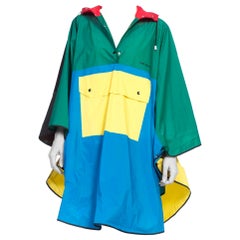Mary Quant Rain Poncho
1980s Ponchos
Mary Quant for sale on 1stDibs
Mary Quant revolutionized the world of women's fashion during the Swinging Sixties. The British designer substantially modernized hemlines, popularizing the miniskirt and essentially introducing hot pants. Quant’s extensive repertoire included a range of garments, some famously modeled by Twiggy. Her liberating and refreshing designs for skirts, blouses, sweaters, knitted jersey dresses and chic stretchy tights challenged the conventions of the day and greatly influenced fashion trends that followed.
Quant was born in London in 1934. She wanted to pursue fashion from a young age, but her parents — both teachers — were unsupportive. She instead studied art and illustration at Goldsmiths College. Quant graduated in 1953, but her interest in fashion persisted, so she headed straight into an apprenticeship at a high-end millinery shop and never looked back.
In the late 1950s, Quant began making her own designs. When her then-boyfriend Alexander Plunket Greene bought a building in Chelsea, London, part of the project was eventually relegated to a boutique named Bazaar. Quant took a few classes at night on tailoring and created clothing that was to be sold out of the space, and her work quickly caught the attention of publications like Harper's Bazaar. Her shirts, modern tunic dresses, and other apparel captured the vitality of the postwar cultural shift occurring at the time. She also cultivated a lively environment in her shop, playing music, serving drinks and staying open for long hours.
While hemlines had been gradually climbing above the knee before her contributions to the explosion in popularity of the miniskirt took shape — see the late 1950s-era pieces that Yves Saint Laurent designed for Dior or the Space Age dresses of Parisian couturier André Courrèges — Quant played no small role in challenging the conventions of traditional womenswear in the 1960s. She viewed the miniskirt as liberating. In the late 1960s, she also introduced short shorts that anticipated the later popularity of hot pants.
Throughout the 1970s and 1980s, Quant focused more on makeup and household goods. In 1988, she designed the interior of the Mini 1000 car, which was originally called the Mini Quant.
Quant earned a great deal of recognition for her contributions to the fashion industry. In as early as 1963, she was the winner of the first Fashion Museum Dress of the Year award. She was appointed Officer of the Order of the British Empire in 1966 and promoted to Dame Commander in 2015. Quant was also awarded the Minerva Medal — the highest honor of the Chartered Society of Designers, of which she was a member.
When the Victoria and Albert Museum held a retrospective devoted to Quant's famous designs from the 1960s and 1970s, Quant was heavily involved in the production of the show.
Find a collection of vintage Mary Quant clothing and accessories on 1stDibs.
Finding the Right Coats-outerwear for You
There is a stylish garment for anywhere in the universe, and on 1stDibs, finding the right vintage and designer coats and outerwear doesn’t have to feel like a journey to the ends of the earth.
Outerwear includes many types of garments aside from the standard coat. From capes, gilets, jackets and cloaks to raincoats and kimonos, fashion designers have long been preparing us for the elements, and outerwear in general has changed and evolved significantly over time.
A lot of the coat styles in our closets, such as the durable Navy-inspired peacoat, were popularized by soldiers who battled aggressive climes in their regulation field jackets and parkas — indeed, keeping troopers comfortable guided the design of the military surplus garments that have often become buzzy fashion trends. Even today, owing to the likes of Burberry, a luxury fashion house that is among the originators of the trench coat worn by British officers during World War I, the trench remains a timeless style, now available in a range of colors that can be worn throughout the year.
While women in late 1700s England donned an adaptation of a men’s jacket called a spencer — the likeness of which could be spotted in Ralph Lauren’s ready-to-wear collections hundreds of years later — designers hadn’t widely been crafting outerwear specifically for women. Generally, the outerwear of choice for the fashionable, well-heeled lady prior to the 1800s usually consisted of capes, shawls and stoles. By the mid-1800s, women were wearing overcoats with multiple layered collars popularized by men (often called a Garrick coat in England), and as women entered the workforce during the 1920s, hemlines climbed, jewelry was prominent and fashion conventions were broken across the board.
Thankfully, the 20th century’s tradition of challenging the norm continues steadfast in today’s outerwear fashions. Contemporary designers certainly find inspiration in 1960s and 1970s coats by Pierre Cardin, Yves Saint Laurent and Bonnie Cashin, but unisex options abound in modern creations that take both function and style into account. Find what inspires you in the full range of vintage and designer coats and outerwear available for sale on 1stDibs.
